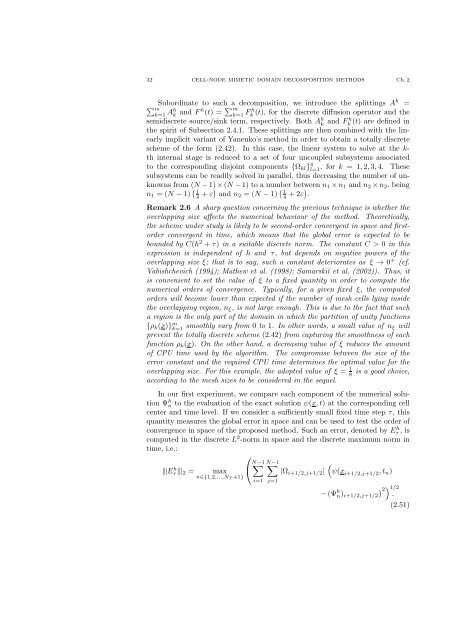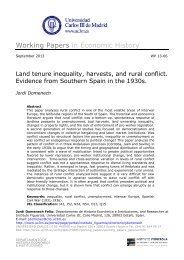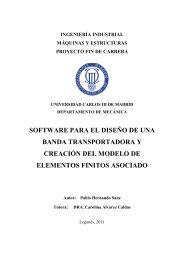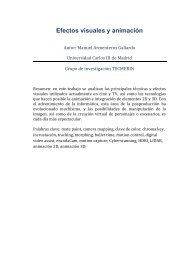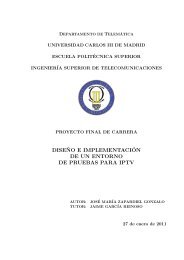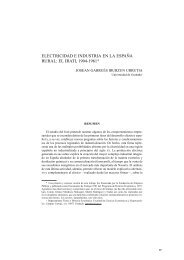Métodos miméticos de pasos fraccionarios - E-Archivo - Universidad ...
Métodos miméticos de pasos fraccionarios - E-Archivo - Universidad ...
Métodos miméticos de pasos fraccionarios - E-Archivo - Universidad ...
Create successful ePaper yourself
Turn your PDF publications into a flip-book with our unique Google optimized e-Paper software.
32 cell-no<strong>de</strong> mimetic domain <strong>de</strong>composition methods Ch. 2<br />
Subordinate to such a <strong>de</strong>composition, we introduce the splittings Ah ∑<br />
=<br />
m<br />
k=1 Ah k and F h (t) = ∑m k=1 F h k (t), for the discrete diffusion operator and the<br />
semidiscrete source/sink term, respectively. Both Ah k and F h k (t) are <strong>de</strong>fined in<br />
the spirit of Subsection 2.4.1. These splittings are then combined with the linearly<br />
implicit variant of Yanenko’s method in or<strong>de</strong>r to obtain a totally discrete<br />
scheme of the form (2.42). In this case, the linear system to solve at the kth<br />
internal stage is reduced to a set of four uncoupled subsystems associated<br />
to the corresponding disjoint components {Ωkl} 4 l=1 , for k = 1, 2, 3, 4. These<br />
subsystems can be readily solved in parallel, thus <strong>de</strong>creasing the number of unknowns<br />
from (N − 1) × (N − 1) to a number between n1 × n1 and n2 × n2, being<br />
n1 = (N − 1) ( 1<br />
4 + ε) and n2 = (N − 1) ( 1<br />
4 + 2ε) .<br />
Remark 2.6 A sharp question concerning the previous technique is whether the<br />
overlapping size affects the numerical behaviour of the method. Theoretically,<br />
the scheme un<strong>de</strong>r study is likely to be second-or<strong>de</strong>r convergent in space and firstor<strong>de</strong>r<br />
convergent in time, which means that the global error is expected to be<br />
boun<strong>de</strong>d by C(h2 + τ) in a suitable discrete norm. The constant C > 0 in this<br />
expression is in<strong>de</strong>pen<strong>de</strong>nt of h and τ, but <strong>de</strong>pends on negative powers of the<br />
overlapping size ξ; that is to say, such a constant <strong>de</strong>teriorates as ξ → 0 + (cf.<br />
Vabishchevich (1994); Mathew et al. (1998); Samarskiĭ et al. (2002)). Thus, it<br />
is convenient to set the value of ξ to a fixed quantity in or<strong>de</strong>r to compute the<br />
numerical or<strong>de</strong>rs of convergence. Typically, for a given fixed ξ, the computed<br />
or<strong>de</strong>rs will become lower than expected if the number of mesh cells lying insi<strong>de</strong><br />
the overlapping region, nξ, is not large enough. This is due to the fact that such<br />
a region is the only part of the domain in which the partition of unity functions<br />
{ρk(x)} m k=1 smoothly vary from 0 to 1. In other words, a small value of nξ will<br />
prevent the totally discrete scheme (2.42) from capturing the smoothness of each<br />
function ρk(x). On the other hand, a <strong>de</strong>creasing value of ξ reduces the amount<br />
of CPU time used by the algorithm. The compromise between the size of the<br />
error constant and the required CPU time <strong>de</strong>termines the optimal value for the<br />
overlapping size. For this example, the adopted value of ξ = 1<br />
8 is a good choice,<br />
according to the mesh sizes to be consi<strong>de</strong>red in the sequel.<br />
In our first experiment, we compare each component of the numerical solution<br />
Ψ h n to the evaluation of the exact solution ψ(x, t) at the corresponding cell<br />
center and time level. If we consi<strong>de</strong>r a sufficiently small fixed time step τ, this<br />
quantity measures the global error in space and can be used to test the or<strong>de</strong>r of<br />
convergence in space of the proposed method. Such an error, <strong>de</strong>noted by E h τ , is<br />
computed in the discrete L 2 -norm in space and the discrete maximum norm in<br />
time, i.e.:<br />
Eh ⎛<br />
N−1 ∑<br />
τ 2 = max ⎝<br />
n∈{1,2,...,NT +1}<br />
i=1<br />
N−1 ∑<br />
j=1<br />
|Ω i+1/2,j+1/2|<br />
(<br />
ψ(x i+1/2,j+1/2, tn)<br />
− (Ψ h n) i+1/2,j+1/2<br />
)2 ) 1/2<br />
.<br />
(2.51)


